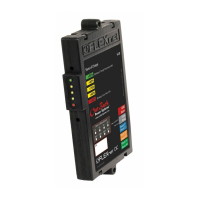Page 14 Page 15
900-0093-12-00 Rev C
©2020 OutBack Power. All Rights Reserved.
Operation Operation
Accessing Historical Data
The FN-DC keeps a data log containing the previous 128 days of data. The MATE3s can save
this data to an SD card so that it can be viewed elsewhere on a spreadsheet. The daily log
includes minimum SOC, number of amp hours and kilowatt hours put into and taken out of the
battery bank, and the battery bank’s net gain or loss of amp hours and kilowatt hours. Data is
logged each night at midnight. Be sure the MATE3s clock is set to the correct local time.
FLEXnet DC DataLog
To access the FLEXnet DC DataLog, use the MATE3s system
display. See page 8 of this document to access the DataLog
screen using the <Battery> soft key.
The upper left corner shows the date of the selected screen.
(The present Datalog screen reads Today).
The <-Day> soft key B brings up the previous day's log (with a
date shown). The <+Day> soft key A advances the log to the
next day. If Today is shown, it does nothing.
FN-DC and the Charging Cycle
One of the primary benefi ts of the FLEXnet DC is its ability to accurately monitor a battery bank’s state of
charge (SOC). While voltage gives an approximation of SOC, this is only accurate if the battery has
stabilized in a resting state for a period of several hours at room temperature. The FN-DC measures
voltage as well as current. This enables the FN-DC to track a net total of how many amp-hours (AH) or
kilowatt-hours (kWh) are removed from, and returned to, the batteries.
A small amount of energy is lost during the charging process, meaning battery charging is not 100% effi cient.
The FN-DC compensates by incorporating the Charge Factor setting in its calculations (typically 94% with
fl ooded lead-acid batteries). This is the percentage of the energy that is calculated to be used for charging.
The rest is discounted as effi ciency losses.
The FN-DC uses the values entered into the Battery Setup screen in the MATE3s (see page 7) to
determine the battery bank’s SOC as a percentage, with 100% being fully charged. In addition to
tracking the amount of energy removed from and returned to the batteries, the FN-DC also checks that the
battery has attained a specifi ed voltage and that the charging current has dropped to the specifi ed ampere
level for the specifi ed amount of time before the FN-DC considers the battery bank fully charged (in FN-DC
parlance, the “charging parameters” have been met). Once the FN-DC reports that charging parameters have
been met and the battery bank is fully charged, the charging cycle is complete.
Three-Stage Charging Cycle
Bulk Stage
The bulk stage is a constant-current stage.
The charge current is maintained at a
constant high level until the voltage reaches
the absorption set point. This voltage is
specifi ed by the battery manufacturer. It is
typically between 14.1 and 14.6 Vdc in a
12-volt system (58 to 59 Vdc in a 48-volt
system , as shown to the right). This setting
must equal or exceed the Charged Voltage
setting on page 7. At the end of the bulk
stage the battery will reach 85 to 90% SOC.
Absorption Stage
Absorption is a constant-voltage stage that
begins when voltage reaches the absorption
set point. The charger limits the current
fl ow to only what is necessary to maintain
this voltage. A high current is required to
raise the voltage to the absorption level.
After reaching this voltage, as long as it is
maintained, the “return amps” requirement is
reduced. The tapering current decreases to a
minimal level, about 1 to 3% of the battery's
amp-hour capacity. This “tops off the tank,”
leaving the battery at 100% SOC.
Float Stage
The fl oat stage maintains the battery at a full state of charge, since batteries will slowly self-discharge
when charging current is removed. Float voltage is typically between 13.0 and 13.5 Vdc in a 12-volt system
(54 to 55 Vdc in a 48-volt system, as shown to the right).
Some chargers maintain the fl oat stage as long as power is available ("24/7" mode). Others maintain it for a
few hours, then go silent until the batteries self-discharge to a "refl oat" setting (not shown). This cycle of fl oat
and refl oat continues until the battery discharges to a much lower "rebulk" setting. This prompts the charger
to restart at the bulk stage, beginning a new charging cycle.
Equalization
Some batteries require a periodic equalization (EQ) charge to maintain optimal battery health. The EQ
process involves applying a charge voltage usually equal to or exceeding the absorption voltage for a
specifi ed amount of time. Equalization is usually specifi ed to occur at intervals of weeks or months,
or after a certain number of charge/discharge cycles. Refer to the equalization instructions provided by
the battery manufacturer.
● Minimum SOC: The lowest SOC for that day.
● Input and Output: The number of amp-hours and kilowatt-hours
brought into or removed from the batteries that day.
● Net: The net gain or loss in amp-hours or kilowatt-hours that day.
This is the difference between the Input and Output fields.
BA

